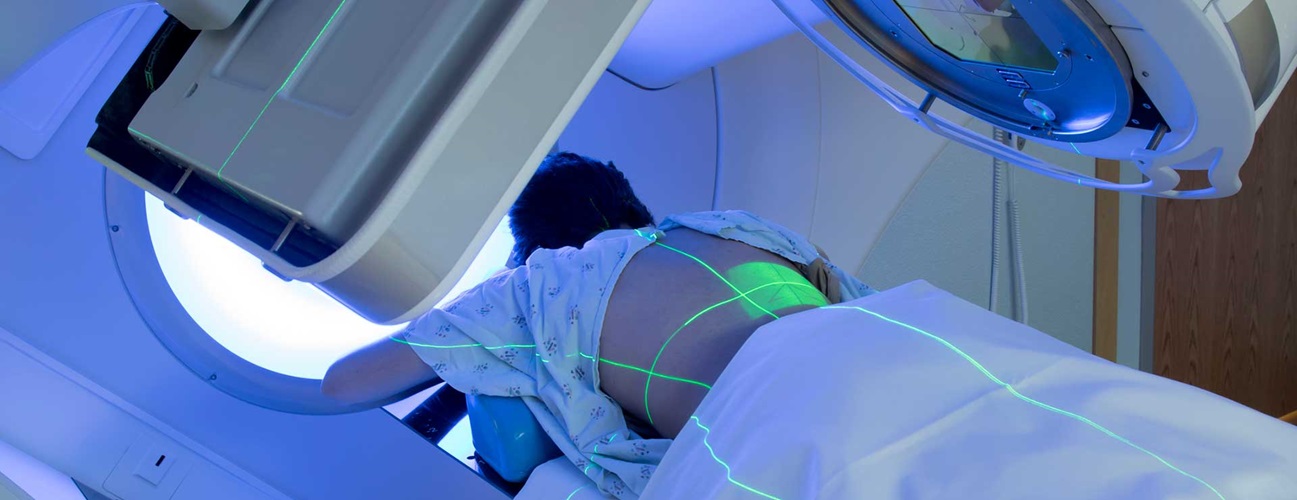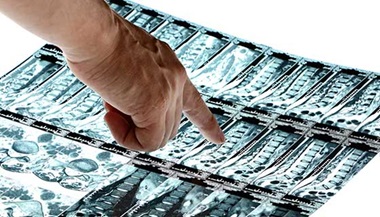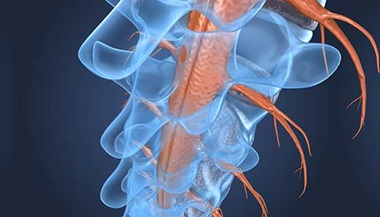Spinal Cancer and Spinal Tumors
A spinal tumor is an abnormal growth arising from any of the tissues that make up the spine. There are many different types of spinal tumors and not all of them are malignant (spinal cancer).
Primary and Metastatic Spinal Tumors
Primary spinal tumors are those that originate in the spine. They are relatively rare, typically benign (noncancerous) and represent a small percentage of spinal tumors. Malignant tumors may also originate in the spine, although more often they spread to the spine from elsewhere in the body.
Metastatic spinal tumors are those that have spread to the spine from other areas of the body. If a tumor is able to spread, this usually means it is malignant. Between 30 and 70 percent of cancer patients develop metastatic spine cancer during the course of their disease. Lung, prostate, and breast cancers are the three most common cancers that tend to spread to the spine.
Where do spinal tumors form?
The spine is not a single location. It is made of different types of tissues that span the entire length of your back and into your neck and pelvis. A tumor can form in almost every type of tissue.
Starting with the outer layers of the spinal column, here are some of the tissues that may develop tumors and cancer in the spine:
-
Bones that form the spinal vertebrae, including the bone marrow inside them
-
Cartilage that protects the joints in the vertebrae
-
Spinal discs that cushion the space between the vertebrae
-
Blood vessels that supply nutrients to the spine
-
Peripheral nerves that exit the vertebrae
-
Dura mater, pia mater and arachnoid mater — three layers of membranes that encase the spinal cord
-
Spinal cord
Based on the location of the tumor in relation to the spinal cord, spinal tumors are classified into three groups:
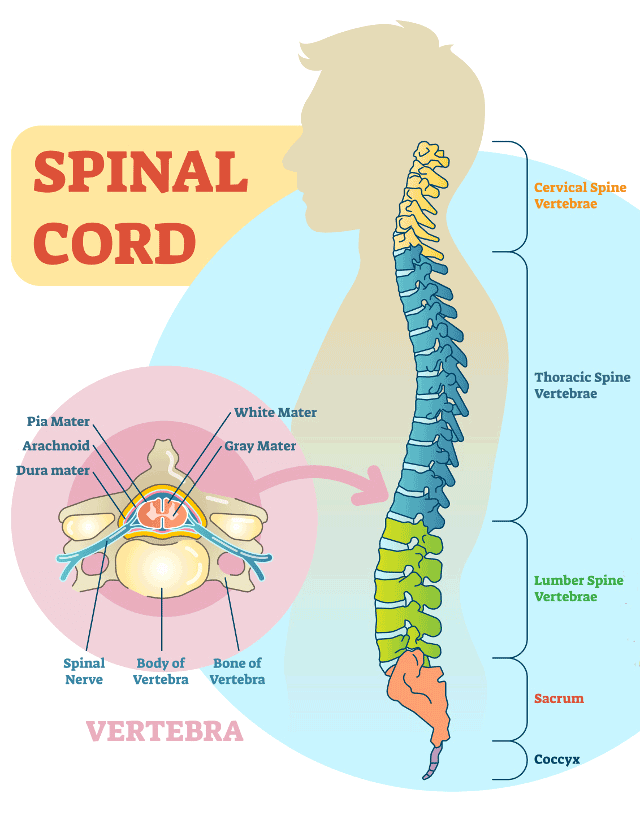
-
Extradural tumors (also known as epidural tumors) form inside the spinal column and may involve the vertebrae, but typically don’t affect the spinal cord. They are often located in the epidural space, which is the area surrounding the outer – dura – membrane that protects the spinal cord.
-
Intradural tumors form inside the dura and may or may not involve the spinal cord.
-
Intramedullary tumors are intradural tumors that grow inside the spinal cord.
Spinal Tumor Types by Aggressiveness
There are several types of masses that can be found in the spine:
-
Some are malignant tumors (spinal cancer), which means they can spread to other areas of the body.
-
Some are benign tumors, which means they are not aggressive and don’t spread, but it doesn’t mean they are harmless.
-
Some may look like tumors but are actually cysts, plaques or similar masses.
Spinal Cancer: Malignant Spinal Tumors
Most spinal cancer occurs inside the spinal column and usually doesn’t affect the spinal cord. Some of the cancers that may involve the spine include:
-
Osteosarcoma: a type of bone cancer that may originate in the spine but is more common in the thigh and shin bones.
-
Chondrosarcoma: a tumor that arises from cartilage cells around the bone. Although uncommon in the spine, it can sometimes develop as a primary cancer in the bones that form the spinal column.
-
Multiple myeloma: a cancer that affects plasma cells in the blood. The affected cells collect in the bone marrow and the outer layer of the bone — often in the spine.
-
Lymphoma: a group of cancers that affect the cells of the immune system called lymphocytes. It may develop in the spine as a primary tumor, but more often it arises elsewhere and spreads to the spine.
-
Chordoma: a malignant bone tumor that can develop inside the spinal column anywhere along its length, however it is most commonly seen in the sacrum (a bone in the base of the spine).
-
Ewing sarcoma: a cancer that can affect both the bone and the surrounding soft tissue. It is rare in adults and represents about 1 percent of childhood cancers.
Benign Spinal Tumors
Although in the majority of cases these spinal tumors are benign, a small percentage of them may become malignant. Benign spinal tumors can cause problems when they grow large enough to press against the tissues of the spinal cord or other structures.
Benign Epidural Tumors
-
Hemangioma: a growth that forms from the tissues of blood vessels inside the spinal column. These tumors are more common on the surface of the skin, especially in infants, but may also affect internal organs.
-
Osteoid osteoma: a small tumor in the bone that is more common in children and younger adults.
-
Osteoblastoma: similar to osteoid osteoma but typically larger and more aggressive.
-
Osteochondroma: an overgrowth of cartilage and bone that usually occurs at the end of the bone near the growth plate.
-
Giant cell tumor (GCT): a tumor that is named for the way it looks under the microscope. It typically contains “giant” cells with multiple nuclei that formed as several cells fused together. GCTs in the spine typically affect the bones of the vertebrae.
Benign Intradural Tumors
-
Meningioma: a tumor that is more common in the brain, but may also affect the dura mater, which is one of the meninges — the linings of the spinal cord.
-
Nerve sheath tumors such as schwannomas and neurofibromas can form on peripheral nerve roots exiting the spine.
-
Glioma: a tumor that grows from glial cells that support the function of the brain and spinal cord. In the spine, the more common types of gliomas are:
-
Ependymoma and subependymoma: tumors that develop in the lining of the passageways in the brain and spinal cord. They can sometimes block the flow of the cerebral spinal fluid, which increases the pressure in the brain.
-
Astrocytoma: the most common spinal cord tumor in children, which can be malignant or benign.
-
-
Hemangioblastoma: a tumor that arises from blood vessels connected to the central nervous system, including the brain and the spinal cord.
Schwannoma Tumor: Arrington’s Story

After turning in bed, Arrington heard a snap and felt instant pain. MRI results showed a broken neck — and a large spinal tumor. Arrington and his fiancée sought out spine neurosurgeon Timothy Witham at Johns Hopkins for care.
Spinal Cysts and Tumorlike Masses
-
Eosinophilic granuloma: benign lesions, rare in adults, that affect bones and may cause a collapse of the vertebrae; they are more common in the mid-back.
-
Epidural lipomatosis: excessive growth of fat inside the epidural space.
-
Synovial cyst: a fluid-filled sac that typically forms in the lumbar spine (lower back) around the vertebral joints, usually from a degenerative process, and is benign.
-
Arachnoid cyst: a fluid-filled sac that may cause separation in the membranes enveloping the spinal cord and may protrude into the epidural space.
-
Aneurysmal bone cyst: a fluid-filled lesion that affects primarily children and is the third most frequent benign bone tumor.
-
Epidermoid and dermoid cysts: hollow growths composed of skin elements that have become implanted in the spinal canal.
-
Syringomyelia: a cyst within a spinal cord that may mimic a tumor but is usually benign.
-
Multiple sclerosis (MS): plaques that may develop in progressive MS can sometimes cause the same symptoms as spinal tumors.
-
Transverse myelitis: an inflammatory disease that causes lesions to form on the spinal cord that may mimic the symptoms and appearance of a spinal tumor.
Spinal Tumor and Spinal Cancer Symptoms
Symptoms of spinal cancer and spinal tumors may vary depending on the tumor type and location. They may include but are not limited to:
-
Back pain and neck pain, which are the most common symptoms of spinal tumors. The pain can be related to the tumor pressing on the nerves or the spinal cord. Or, it can be caused by changes in the alignment of the spine affected by the tumor.
-
Neurologic problems related to spinal tumors. These may include:
-
Radiculopathy (pinching of the nerve roots)
-
Myelopathy (spinal cord compression)
-
Bowel and bladder issues due to compression of the nerves that provide sensation and function to these organs
-
Numbness, tingling and muscle weakness
-
Difficulty walking
-
Paralysis
-
-
If the tumor grows large enough to shift the spinal alignment, it may also cause scoliosis, kyphosis and similar deformities.
Spinal Tumor and Spinal Cancer Diagnosis
When a tumor is found anywhere in the spine, the first step is usually to determine whether it is a primary or a metastatic tumor. Your doctor will likely order a variety of tests to check your spine, as well as other major organs and systems where cancer may develop. These tests and other diagnostic methods may include:
-
Your full medical history
-
Physical examination
-
Neurological examination, including pain and function assessment
-
Positron emission tomography (PET scan)
A biopsy may be necessary to confirm the exact type of tumor, especially if it is a primary tumor. Biopsy may require surgery, but in some cases a needle may be used to reach the tumor and extract a sample.
‘Grateful and Impressed’

In his new memoir, actor Michael J. Fox details his experience with Dr. Nicholas Theodore and the Neurosurgical Spine team, who removed a large spinal tumor to avert paralysis.
Spinal Tumors and Spinal Cancer Treatment
Treatment for spinal cancer and spinal tumors will differ based on the tumor type, aggressiveness and many other factors. Your treatment options may include:
-
Chemotherapy
-
Radiation therapy, including new advances in therapeutic radiology such as targeted proton therapy
-
Full or partial surgical removal of the tumor
-
Steroids to help with swelling and back pain
Certain benign spinal tumors and cysts may not need treatment if they don’t cause any symptoms.
The Johns Hopkins Proton Therapy Center
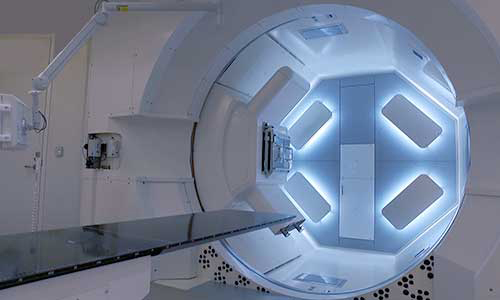
Proton therapy is used to treat certain tumors in children and adults. Our treatment center, located at Sibley Memorial Hospital in Washington, D.C., combines advanced proton therapy technology, the latest research and caring specialists.

